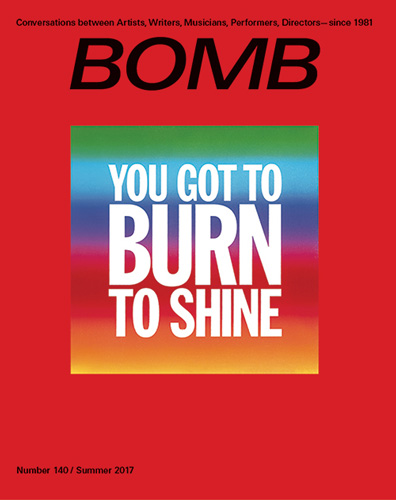BOMB Magazine – Summer 2017
BOMB puts artists in conversation with each other. In the Summer 2017 issue, art is broadly defined and equally celebrated: poets and directors and architects, all are welcome at the table to open up the discussion on art, its legacy, history, and future. Particularly through reviews and interviews, BOMB lays bare artists’ inspiration, where creators and their creations speak to each other across time.
BOMB puts artists in conversation with each other. In the Summer 2017 issue, art is broadly defined and equally celebrated: poets and directors and architects, all are welcome at the table to open up the discussion on art, its legacy, history, and future. Particularly through reviews and interviews, BOMB lays bare artists’ inspiration, where creators and their creations speak to each other across time.
Clinton Krute reviews Albert Serra’s film The Death of Louis XIV, beginning the dialogue on how art is built on a legacy. Krute balances the plot of the film (King Louis XIV is dying) with the director’s choices and enough context on French film history to understand why this film matters today. Krute may use terms such as “French New Wave cinema,” but never fails to provide context. We don’t need the details on what French New Wave is to understand Krute’s film criticism that links “the decadence of an eighteenth-century court and the decline of the generation that has dominated post-war twentieth-century culture and politics.” For readers without a background in academic film studies, Krute provides a simple overview of the film that generates a viewer’s interest to see the work for themselves.
When Frank Gesualdi interviews Sharon Johnston and Mark Lee—of the architectural firm Johnston Marklee—the three address the necessity of history to inform the architecture of the present. The interview highlights Johnston Marklee’s current projects, including the Chicago Architecture Biennial which they’ve titled: Make New History. As Lee explains, they chose this title because “progress is related to an engagement with history [ . . . ] we wish architecture could be less cyclical, less revolutionary and more continuous in its evolution.” For Johnston and Lee, it is both more radical and more effective to build upon the work of their predecessors, instead of rejecting that legacy. Readers will not need a background in architecture to be drawn to Johnston Marklee’s approach and the stunning accompanying photographs of their work.
The strength of BOMB’s interviews come from the rapport between the interviewer and the subject. In the case of Porochista Khakpour interviewing Lidia Yuknavitch, the two are friends. Khakpour interviews Yuknavitch about her most recent novel The Book of Joan, a futuristic speculative fiction novel on Joan of Arc. Yuknavitch relays the importance of uncovering the “female badasses” of history and as the interview progresses, a female writing legacy emerges through Yuknavitch’s words. She says, “we are walking body stories: our own as well as stories that came before us and stories that will come after.” The power of this interview is in how Khakpour and Yuknavitch take us on a literary journey through Yuknavitch’s body of work and the stories of other female speculative fiction authors. From this interview alone, you’ll have a dozen books to put on your reading list.
The centerpiece of this issue is dedicated to the poet and activist John Giorno. Spanning Giorno’s career from The American Book of the Dead (1964) up through the present, BOMB returns to Giorno throughout this issue with an interview, two of his poems, and a curation of photographs and fliers from the John Giorno archive. Verne Dawson’s interview establishes Giorno in the history of poetry. As a performing poet, Giorno speaks about his poetic inspirations T.S. Eliot and Dylan Thomas, but how “[i]n the 1940s, there was no such thing as a poetry reading.” Dawson’s interview becomes a history of Giorno’s relationship with the art and poetics scene of New York in the 1960s. It’s this same sense of time and culture, that leads to Giorno’s most-recent poem “Wish-Fulfilling Jewels & the Poet.” He traced his father’s lineage back to Italy in the late thirteenth century where his relative, Donus Pane et Vitum, was a priest. This poem that crosses time and space where Giorno utilizes modern language with fluidity and grace, “We are 13th-century cross-dressing priests, / drag queens.” With fantasy elements, Donus knows of Giorno, knows of the past and the future, further linking history and the present. Giorno’s poem bridges the gap between history and today through storytelling.
BOMB is a conversation between artists, and this issue reveals the legacies each artist inherits. No one creates in a vacuum. Every piece published is inspiration for future artists to create, to add to this legacy, and build upon the continuous history of art and artists. Let BOMB start your conversation.
[www.bombmagazine.org]





